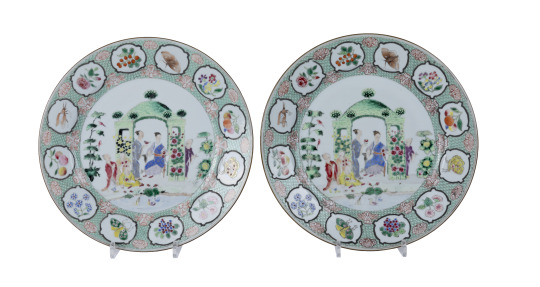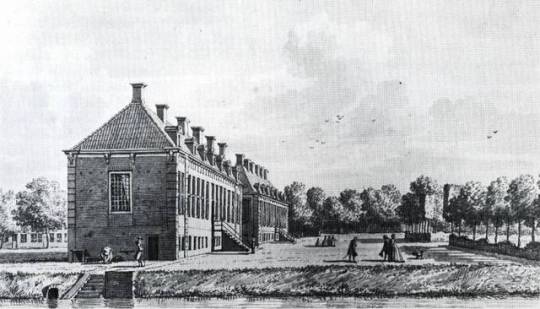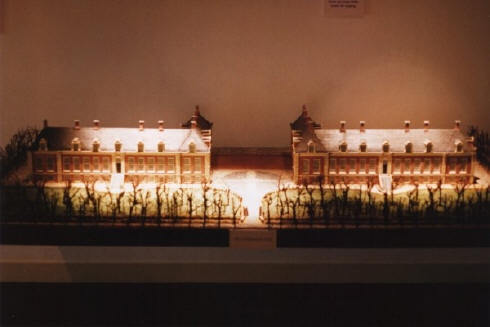#cornelis pronk
Explore tagged Tumblr posts
Photo

CORNELIS PRONK
On this day of 10th December, Cornelis Pronk (10 December 1691 – 28 or 29 September 1759), also known as Cornelis Pronck, was born in Amsterdam, Netherlands.
He was a draughtsman, painter, and porcelain designer, known particularly for his numerous drawings of cities, towns, and buildings, as well as for his porcelain designs.
Pronk started to take lessons in drawing and painting from the painter Jan van Houten and from portrait painter Arnold Boonen
In 1715 he established himself as a painter, joining the Saint Lucas guild of painters. Early in his career, he was primarily a portrait painter and a copyist.
He was also known as a painter of theatre sets.
Pronk toured the Dutch Republic, usually on foot, to sketch views of cities, towns, and landscapes, as well as castles, stately homes, and other buildings, documenting in detail. Each of these field sketches would form the basis for one or several drawings, which he produced back in his studio. On his travels, he would occasionally cross the border into Germany, when he made drawings around Kleve and Cologne.
Together with his pupils Jan de Beijer and Abraham de Haen produced over 700 drawings for Het verheerlykt Nederland (The glorified Netherlands), a multi-volume work documenting all the provinces of the Dutch Republic. Many of his drawings were turned into engravings by other artists such as Hendrik Spilman and Simon Fokke. Pronk also contributing drawings to a 1760 atlas of the province of Zeeland, Een en twintig gezigten der stemmende steden van Zeeland en derzelver voorname gebouwen.
Pronk's drawing technique was to use subtle lighting and shadow effects and also added numerous anecdotal details to his drawings. Thereby the drawings attained not only a documentary but also artistic value. Pronk's drawings are characterized by clear, simple lines that captured the essence of the buildings he depicted. He knew how to leave out details that would have crowded the drawings.
Pronk's sketchbooks are in the collection of the Rijksprentenkabinet (National Cabinet of Prints), now part of the Rijksmuseum in Amsterdam.
In 1997, the Frans Hals Museum in Haarlem held an exhibition of Pronk's work.
0 notes
Photo

"La Dame au Parasol" plate, Cornelius Pronk, c. 1736-1738, Minneapolis Institute of Art: Decorative Arts, Textiles and Sculpture
La Dame du Parasol, after Cornelis Pronk; salmon cell pattern border; small panels of ladies and bird cartouches The Dutch East India company sent designs by Cornelius Pronk to Japan as well as China to be copied onto porcelain. Japanese painters were paid more than their Chinese counterparts, which led the the Dutch to cancel the order. However, several plates using "the lady with a parasol" design, including the one shown here, were produced on a purely private basis. Size: 1 1/4 x 10 7/16 in. (3.18 x 26.51 cm) Medium: Porcelain
https://collections.artsmia.org/art/4934/
10 notes
·
View notes
Photo

Dish, Cornelis Pronk, ca. 1736–38, Metropolitan Museum of Art: European Sculpture and Decorative Arts
Purchase by subscription, 1879 Size: Diameter: 6 1/8 in. (15.6 cm) Medium: Hard-paste porcelain
https://www.metmuseum.org/art/collection/search/185924
1 note
·
View note
Photo

Self-Portrait, Museum of the Netherlands
Zelfportret van de schilder Cornelis Pronk. Buste in ovaal.
http://hdl.handle.net/10934/RM0001.COLLECT.5103
1 note
·
View note
Photo

A pair of Chinese export famille-rose 'arbor' pattern plate circa 1740
Estimate: €3000 - €4000 Result: € 2600
Sale December 8-9: Winter Tales pt. 1, Old Master Paintings & Antiques
In the fourteenth century, Europe is introduced to the Chinese porcelain craft. The objects are seen as pure luxury: they’re pricey, rare and artisan-made. By the sixteenth century, the Portuguese establish a direct sea-route to the Far East, around the Cape of Good Hope. Between the sixteenth and the eighteenth century, some 300 million works of Chinese porcelain reach Europe. Encouraged by the blooming trade routes to Europe, Chinese craftsmen begin producing porcelain aimed solely at the European consumer. The objects are still made in the Chinese way, but in a more western fashion of style and decorative value.
These two plates are ordered by the Vereenigde Oostindische Compagnie. It’s one of four commissioned designs after drawings by Dutch draftsman Cornelis Pronk between 1736 and 1739. The plates are a clear example of the hybrid nature of Chinese export-porcelain. The central scene hovers between Chinese and chinoiserie. The decorated border fuses Chinese and European elements: flowers and butterflies combined with a shell-patterned background. The so-called famille rose-glazing technique has European roots and was introduced to the Chinese by the Jesuit missionaries. The Chinese however perfected the technique, and as a result the Chinese famille rose-porcelain was the most artistically refined work in eighteenth-century China.
2 notes
·
View notes
Text

www.orientalceramics.com
A Chinese Export Porcelain Plate after the ‘Arbour’ design by Cornelis Pronk (1691 – 1759) commissioned by the Dutch East India Company (Verenigde Oost-Indische Compagnie or V.O.C.) in 1737. This design is mentioned in the V.O.C. archives, it is perhaps his fourth design for the company.
#robertmcphersonantiques #voc #chinedecommande #cornelispronk #chineseexportporcelain #ladameauparasol #dutcheastindiacompany #doctorsvisit #chinedecommande #chinaforthewest #18thcenturyporcelain #qianlongporcelain
0 notes
Text
Day 10: Thursday June 13–Cut & Paste
The day started with a short tensha (decal) application workshop. Sticking these silkscreened waterslide decals onto porcelain is a lot of fun and I felt relieved that it’s actually possible to achieve interesting results with such simple means – a rarity within the porcelain field, I feel. Apart from cutting there’s no skills necessary!
The quality and subtlety of the specialized tensha silkscreening technique is really exceptional in Japan. Complex surface effects, like matte and gloss, faux-embossing, metallic and overlapping shapes can all be done using tensha. I cut and pasted a couple of elements from sample sheets onto a tile. To see the end result, it needs to be fired first. I will try to achieve overlapping effects by making similar collages to spreads from 4 Fragments.




Elements cut from tensha sheets are dunked in water until the top silkscreened layer soaks off the bottom plastic layer and stuck onto the porcelain surface.

My hastily put together tensha collage.

My painting teacher mrs. Nagao suggested this method to combine sengaki and tensha – in pretty much identical fashion to the Twin Mirrors drawings I made using manga screentone sheets.

Meeting with Shoji Kaneko, artistic director at Gen-emon.
I was surprised to hear the owner of the Gen-emon, mister Shoji Kaneko, was interested in meeting me again. I gave him a short presentation about my work, after which he expressed his interest in a possible collaboration. I am interested in making something explicitly for this prestigious kiln (one of the three high ranking pottery kilns in Arita) with its impressive heritage (creating a dinner service set for the Emperor a.o.) and its idiosyncrasies. This kiln’s characteristics are as follows: a specific colour range (red, blue, green and sometimes gold), their “scaled” dami-brush effect and their very small “sakura” flower and arabesque “Karakusa” motifs.

Gen-emon’s tiny flower motif

Gen-emon’s idiosyncratic Dami style

Gen-emon Karakusa (”Plant”) motif
The fun will be in the translation part: Gen-emon actually has a long history in translating design ideas by foreigners into proper Japanese aesthetics. Being one of the first professional pottery houses in the Arita area, they got in contact with the VOC (Dutch East India Company) to produce porcelain ware to export overseas. They even reinterpreted porcelain designs by Dutch porcelain designer Cornelis Pronk in the 18th Century. The Chinese also did this, but needless to say the Arita rendition is much more exquisite.

Dish Depicting Lady with a Parasol, design attributed to Cornelis Pronk, ca. 1734–37, Dr. and Mrs. Roger G. Gerry Collection, The Metropolitan Museum of Art, New York
0 notes
Photo

by Cornelis Pronk, Asian Art
Medium: Porcelain with underglaze blue (Hizen ware, Ko Imari type)
Dr. and Mrs. Roger G. Gerry Collection, Bequest of Dr. and Mrs. Roger G. Gerry, 2000 Metropolitan Museum of Art, New York, NY
http://www.metmuseum.org/art/collection/search/49324
1 note
·
View note
Text
Sermões em Áudio - Pacote 08
Sermões em Áudio – Pacote 08
BAIXAR Nº Tema Pregador 071 O Cristão e a Corrida Com Cristo Joel Beeke 072 A Busca da Glória de Deus Joel Beeke 073 Vendo a Glória de Deus Joel Beeke 074 Romanos 1:16-32 Cornelis (Neil) Pronk 075 Puritanismo e Piedade Cornelis (Neil) Pronk 076 A Oferta Universal do Evangelho Cornelis (Neil) Pronk 077 Pregação Ungida Pelo Espírito Cornelis (Neil) Pronk 078 Arthur W.…

View On WordPress
0 notes
Link
Alkmaar – lange tijd was men zich nauwelijks bewust van de geschiedenis van het grasveld naast de kerk.
Het werd gebruikt als fiestenstalling en hondenuitlaatgebied.
De gemeenteraad besloot dat dit anders moest met het eeuwenoude kerkhof dat stamt uit de 11e eeuw.
De herinrichting van het kerkhof naast de Grote Sint Laurenskerk is binnenkort voltooid.
In overleg met de kerkeigenaar, de exploitant, omwonenden en de Historische Vereniging Alkmaar is hiervoor een ontwerp gemaakt.
De begraafplaats krijgt een respectvoller uitstraling en het plein wordt een groene verblijfsplek.
Op donderdag 5 september is de ceremoniële ingebruikstelling. Tijdens de ceremonie zingt het Alkmaarse klassieke zangtalent Sterre van Boxtel.
Het plein voor de kerk is meegenomen in de planvorming. Het plein een nadrukkelijker invulling als verblijfsgebied, met plantvakken in de vorm van kerkramen, kleurige bloemen als glas-in-lood en bankjes.
De bijeenkomst vindt plaats in de Grote Sint Laurenskerk, op donderdag 5 september om 13.30 uur. Belangstellenden zijn welkom om deze bij te wonen. Aanmelden hiervoor kan via [email protected]
Tekening van Cornelis Pronk, 1727, Kerk met kerkhof in de 18e eeuw (collectie Regionaal Archief Alkmaar).
Bron: gemeente Alkmaar.
0 notes
Photo

The Church and Ruins of Rijnsburg, Seen from the Northeast
Cornelis Pronk (Dutch, Amsterdam 1691–1759 Amsterdam), 1753
View full size image
0 notes
Photo


Tekening van Oranjewoud in 1754. Johan Willem Friso had begin achttiende eeuw de intentie om in Oranjewoud een paleis neer te zetten. de architect Daniel Marot maakte daarvoor een ontwerp en de bouw ervan begon in 1708. Maar het paleis werd nooit voltooid en na een lange periode van verwaarlozing uiteindelijk begin 19e eeuw afgebroken. Hier zien we de twee wel gebouwde vleugels in 1754 op een tekening van Cornelis Pronk en daaronder op een maquette. In het midden had de architect het eigenlijke hoofdgebouw, iets naar achteren willen bouwen maar het dat is er dus nooit van gekomen. Na de afbraak is er in de 19e eeuw een aardig landhuis neer gezet dat ook Oranjewoud heet en er nog wel altijd staat.
0 notes
Photo

Dish by Cornelis Pronk, Metropolitan Museum of Art: European Sculpture and Decorative Arts
Purchase by subscription, 1978 Metropolitan Museum of Art, New York, NY Medium: Hard-paste porcelain
http://www.metmuseum.org/art/collection/search/185928
6 notes
·
View notes
Photo

The Company of Captain Roelof Bicker and Lieutenant Jan Michielsz Blaeuw in front of the De Haan Brewery at the Corner of the Geldersekade and the Boomsloot (called the Lastage), Museum of the Netherlands
Het vendel van kapitein Roelof Bicker en luitenant Jan Michielsz Blaeuw bij de bierbrouwerij de Haan op de hoek van de Lastage (hoek Geldersekade en Boomsloot) te Amsterdam, 1639. Geportretteerd zijn: Pieter Hulft (vaandrig), Dirck de Lange (sergeant), Jochem Rendorp (sergeant), Hendrick Gerritsz Velthoen, Jan Jorisz Eenhoorn, Coenraet Rogiersz Ramsden, Johannes Rombouts, Willem Jansz Steenwijck, Jan Hulft, Claes Rotterdam, Clemens van Sorgen, Jan Martensz Troost, Hendrick Jansz Dommer, Paulus van Walbeeck, Jan Cornelisz Moyaert, Hendrik Jorisz Fuyck, Abraham Pietersz Kroock, Cornelis Wilkens, Adriaen Jorisz Eenhoorn, Isaac van de Venne, Jan Cornelisz Pronk, Gerrit Jacobsz Indischerave, Dirck Joosten Rijskamp, Renier Redinckhoven, Wynant Arentsz Oppyn en Cornelis Wilkens Jr. Uiterst links heeft de schilder zichzelf afgebeeld.
11 notes
·
View notes
Photo

http://www.orientalceramics.com/ A Chinese Export Porcelain plate with the ‘The Pekinese and the Parrots’ pattern, early Qianlong c.1735 -1745. Perhaps from the studio of Cornelis Pronk (1691-1759). Decorated at the centre in blue enamel with a leaping pekinese dog, the iron-red trellis border reserved with parrot and other bird cartouches. This design displays close similarities to those drawn up by the Dutch draughtsman, Cornelis Pronk, who was commissioned by directors of the Dutch East India Company from circa 1734-1738.
0 notes
Photo

18th century Cornelis Pronk - Child from the Kardinaal family
(Amsterdam Museum)
36 notes
·
View notes